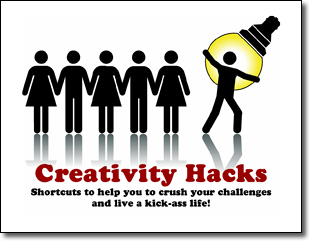If you need new ideas to solve a problem or challenge, you have a myriad of proven creativity techniques you can use. But one of the most productive ways is to adapt a solution that has been successful in another industry or market.
In other words, you can leverage other people’s ideas.
But isn’t that plagiarism?
Not exactly.
What you’re seeking are not ideas you can steal outright, but those you can ADAPT to meet your needs. Your goal is to get inspired by what they accomplished and to use it to drive your own creative thinking – not to copy their approach exactly. As Thomas Edison once said:
“Make it a habit to keep on the lookout for novel and interesting ideas that others have used successfully. Your idea needs to be original only in its adaptation to the problem you are working on.”
Totally new-to-the-world ideas are very uncommon. Most innovation happens as a result of inventors building upon the discoveries of others. In fact, that’s been the basis of scientific discovery for centuries – make a creative breakthrough and publish the results. Learn from the work of others and then extend your thinking in new, creative directions. Why not follow their example?
How to use this technique
1. Look for industries or markets similar to yours. They could be industries that are adjacent to the ones in which you now compete, or those that have a similar base of technologies and sales channels (e.g., you both go to market via two-step distribution channels). Limit your research to these industries for now, but don’t be afraid to expand beyond them if you need more creative inspiration.
2. Conduct a Google search of your problem or challenge. Look for trade magazine articles, white papers, blog posts and other content that describes how other people and organizations approached it and how they creatively solved it.
3. Interview experts: If the people and companies you have identified are in non-competing industries, don’t be afraid to contact them to ask questions and to learn more about their solution. If they’re willing to share, chances are you’ll learn a lot!
4. Ask yourself insight-producing questions: As you conduct research on ideas and solutions you can potentially adapt, get in the habit of asking yourself these questions:
- How can I use this?
- What parts of this solution could be applied with some modification to my current challenge?
- How can I model the thinking process they used to arrive at this solution?
- What unique assumptions did they make that led their thinking in the direction they took? How did this lead them to the winning solution?
This last question is particularly important. One of history’s most famous inventions provides a case in point:
For several centuries, inventors had dreamed of building a flying machine. But no one had succeeded, because they used the flapping wings of birds as their inspiration. The Wright Brothers took a different tack, studying the construction of the wings of birds to intuit their airfoil-like shape. They also used their knowledge of bicycle design and repair to create an aircraft design that relied on banking to turn (in much the same way that you steer the front wheel and bank a bike to turn it) and was light enough to stay aloft. (source of this story: Shortcut: How Analogies Reveal Connections, Spark Innovation, and Sell Our Greatest Ideas by John Pollack)
Here are some additional questions from creativity expert Michael Michalko, author of the excellent creative problem solving book Thinkertoys: A Handbook of Creative Thinking Techniques, that you can use to adapt existing ideas to your needs:
- What else is like this? What other ideas does it suggest?
- Does the past offer a parallel?
- What could I copy? Whom could I emulate?
- What idea could I incorporate?
- What other process could be adapted? What else could be adapted?
- What different contexts can I put my concept in?
- What ideas outside my field can I incorporate?
So the next time you need a creative idea, follow these steps to first determine what has already been tried in other markets and industries. Look for successful solutions you can adapt to your needs. Chances are, you’ll uncover some fascinating approaches and will save yourself a lot of time that would have otherwise been wasted trying to brainstorm and implement a totally new solution.
One final reminder: Be inspired by the work of others. But don’t plaigiarize!
 Creativity Hacks will inspire you to explore in new places, to make new connections, to dig deeper and discover new insights. It will help you to seek out new knowledge and sources of inspiration - so you can profit from the opportunities all around you. When you're done reading Creativity Hacks, you'll be:
Creativity Hacks will inspire you to explore in new places, to make new connections, to dig deeper and discover new insights. It will help you to seek out new knowledge and sources of inspiration - so you can profit from the opportunities all around you. When you're done reading Creativity Hacks, you'll be:
- Empowered to solve problems and tackle challenges head-on.
- Able to see ideas and opportunities everywhere.
- Able to differentiate yourself and advance your career faster.
Above all, you'll learn that creativity is a skill YOU can cultivate!


Excellent post! We can be inspired by the idea of others. I like Michael Michalko's list of questions of how to adapt previous ideas to your needs.